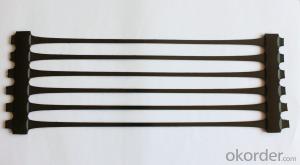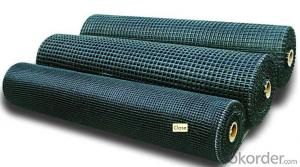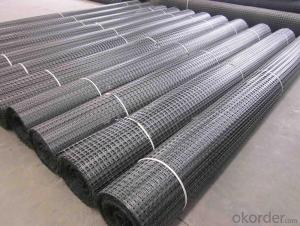Woven Geogrids - Fiberglass Geogrid with Regular Standard Size
- Loading Port:
- Shanghai
- Payment Terms:
- TT OR LC
- Min Order Qty:
- 50000 m²
- Supply Capability:
- 200000 m²/month
OKorder Service Pledge
OKorder Financial Service
You Might Also Like
Fiberglass Geogrid with Regular Standard Size
Description Of Fiberglass Geogrid with Regular Standard Size:
Fiberglass geogrid is a kind of new favorable earthwork base material to strengthen the road surface and roadbed.This product is made by weaving and covering fiberglass filament. It is featured by high vertical and horizontal tensile strength,low unit extension, high flexibility, and favorable high and low temperature resistance.The products after surface covering own the favorable property of alkali resistance and aging resistance. It is used widely to increase the asphalt road surface, concrete road and roadbed (both soft and hard road surfaces).Compared with the traditional road surface, it reduces the cost, prolong the service life, and avoid the reflection road crackle.This product is also used to strengthen the soft land, such as railway, airport, irrigation work, and dyke, etc, and the roadbed.
Main Features of Fiberglass Geogrid with Regular Standard Size:
1) High tensile strength; low elongation; high modulus; high temperature resistance
2) Corrosion resistance; ageing resistance,
3) Good toughness; good physical and chemical stability, thermo-stability
4) Stick-to-active for performance exchanging during long-term using
Specifications of Fiberglass Geogrid with Regular Standard Size:
Tensile Strength (KN) | Warp | >30 | >50 | >60 | >80 | >100 | >120 | >150 | >200 |
Weft | >30 | >50 | >60 | >80 | >100 | >120 | >150 | >120 | |
Elongation(%) | <4< p=""> | <4< p=""> | <4< p=""> | <4< p=""> | <4< p=""> | <4< p=""> | <4< p=""> | <4< p=""> | |
Mesh Size(mm) | 25.4*25.4 | 25.4*25.4 | 25.4*25.4 | 25.4*25.4 | 25.4*25.4 | 25.4*25.4 | 25.4*25.4 | 25.4*25.4 | |
Elastic Modulus | 76 | 76 | 76 | 76 | 76 | 76 | 76 | 76 | |
Width(m) | 1~6 | 1~6 | 1~6 | 1~6 | 1~6 | 1~6 | 1~6 | 1~6 | |
Length(m) | 50~300 | 50~300 | 50~300 | 50~300 | 50~300 | 50~300 | 50~300 | 50~300 | |
Temperature Resistant(℃) | -100~280 | -100~280 | -100~280 | -100~280 | -100~280 | -100~280 | -100~280 | -100~280 | |
Resin Content (%) | 18~20 | 18~20 | 18~20 | 18~20 | 18~20 | 18~20 | 18~20 | 18~20 | |
Glue Type | Bitumen PVC SBR soakage | Bitumen PVC SBR soakage | Bitumen PVC SBR soakage | Bitumen PVC SBR soakage | Bitumen PVC SBR soakage | Bitumen PVC SBR soakage | Bitumen PVC SBR soakage | Bitumen PVC SBR soakage | |
Applications of Fiberglass Geogrid with Regular Standard Size:
1. Maintenance of old asphalt road reinforcement of asphalt pavement.
2. Converting old cement concrete road into composite road.
3. Restraining reflection cracking caused by block shrinkage.
4. Preventing and controlling the cracking caused by new and old combination and uneven settlement.
5. Road extension.
6. Reinforcement of soft soil foundation and overall strength of roadbed.

IMages of Fiberglass Geogrid with Regular Standard Size:
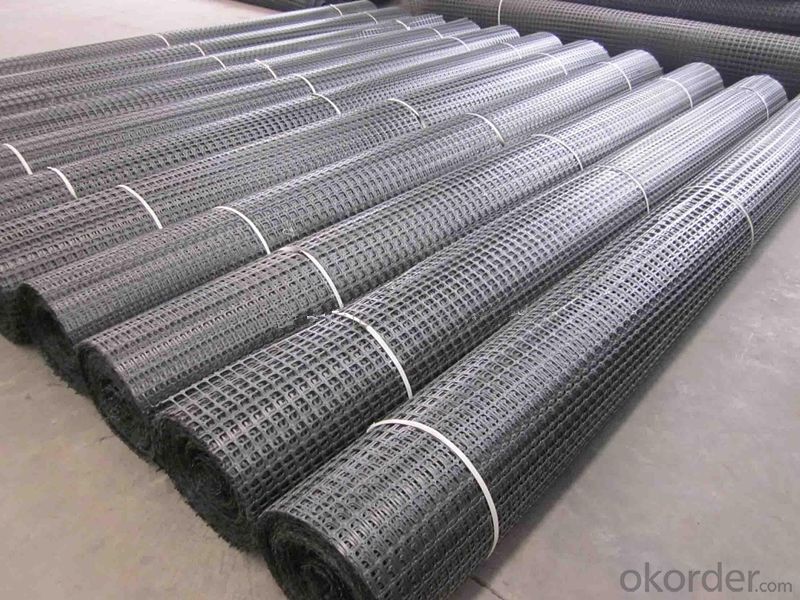


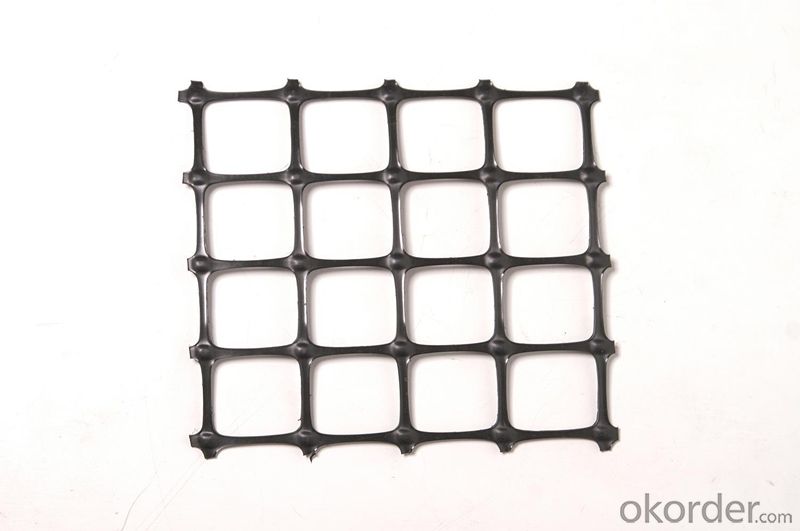



FAQ of Fiberglass Geogrid with Regular Standard Size:
1. What are we supplying?
We are specialized in producing Geosynthetic materials, like Geogrid Series, HDPE Geocell, Geonet, Geotextile, Geomat, Tri Denmensional Composite Grainage Geonet, and Geomembrane Series.
.
2. How Many years experience do we have?
We have been exported to more than 20 countries in the past 15 years.
3. How long do we usually reply your request?
We always reply our customer within 24 hours.
- Q: Especially in the curtain wall project
- I'm studying traffic and civil engineering
- Q: Are geogrids suitable for reinforcing bridge abutment backfills?
- Yes, geogrids are suitable for reinforcing bridge abutment backfills. Geogrids are commonly used in civil engineering projects to enhance soil stability and provide reinforcement. They can effectively distribute the load and prevent soil movement, thereby improving the overall strength and performance of bridge abutment backfills.
- Q: Can geogrids be used in construction of temporary access roads over soft ground?
- Yes, geogrids can be used in the construction of temporary access roads over soft ground. Geogrids provide reinforcement and stabilization to the soil, distributing the load and preventing excessive settlement and rutting. This makes them an effective solution for creating temporary access roads that can withstand heavy traffic and adverse ground conditions.
- Q: Are geogrids resistant to microbial attack?
- Yes, geogrids are generally resistant to microbial attack. Their construction materials, such as polyester or polypropylene, are not easily degraded by microorganisms, making geogrids a durable and long-lasting solution in various applications.
- Q: Are geogrids effective in reducing differential settlement?
- Yes, geogrids are effective in reducing differential settlement. Geogrids provide reinforcement to the soil, increasing its strength and improving load distribution. This helps to minimize differential settlement by preventing uneven settling of the ground.
- Q: Panzhihua steel plastic composite geogrid manufacturers, how much money, where to sell
- But in the actual project, after the packing compaction, therefore has not been subjected to the ultraviolet light and the oxygen erosion, therefore completely may satisfy the permanent construction request.
- Q: Can geogrids be used in retaining walls for recreational areas?
- Yes, geogrids can be used in retaining walls for recreational areas. Geogrids provide reinforcement and stability to the soil, increasing the strength of the retaining wall. This allows for the construction of taller, more durable walls that can withstand the lateral pressure exerted by the soil, making them suitable for recreational areas where safety and longevity are important considerations.
- Q: Are geogrids suitable for use in railway ballast reinforcement?
- Yes, geogrids are suitable for use in railway ballast reinforcement. Geogrids are designed to provide structural support and increase the stability of railway ballast. They help distribute loads and prevent lateral movement of the ballast, enhancing the overall performance and longevity of the railway track.
- Q: Are geogrids effective in preventing soil erosion on slopes without vegetation?
- Yes, geogrids are effective in preventing soil erosion on slopes without vegetation. Geogrids are synthetic materials that are designed to reinforce and stabilize soil, providing structural support to prevent erosion. They are commonly used in areas where vegetation is not present or cannot be established, such as construction sites or steep slopes. Geogrids improve soil stability, distribute load forces, and enhance water drainage, effectively reducing soil erosion.
- Q: What is the effect of temperature on geogrid properties?
- The effect of temperature on geogrid properties can vary depending on the specific material and design of the geogrid. In general, higher temperatures can cause the geogrid to expand and become more flexible, which can result in increased tensile strength and improved load-bearing capacity. However, extreme temperatures, either high or low, can also lead to a decrease in geogrid properties, such as reduced stiffness and reduced resistance to deformation. Therefore, it is important to consider the temperature conditions in which the geogrid will be used to ensure optimal performance and longevity.
Send your message to us
Woven Geogrids - Fiberglass Geogrid with Regular Standard Size
- Loading Port:
- Shanghai
- Payment Terms:
- TT OR LC
- Min Order Qty:
- 50000 m²
- Supply Capability:
- 200000 m²/month
OKorder Service Pledge
OKorder Financial Service
Similar products
Hot products
Hot Searches
Related keywords
